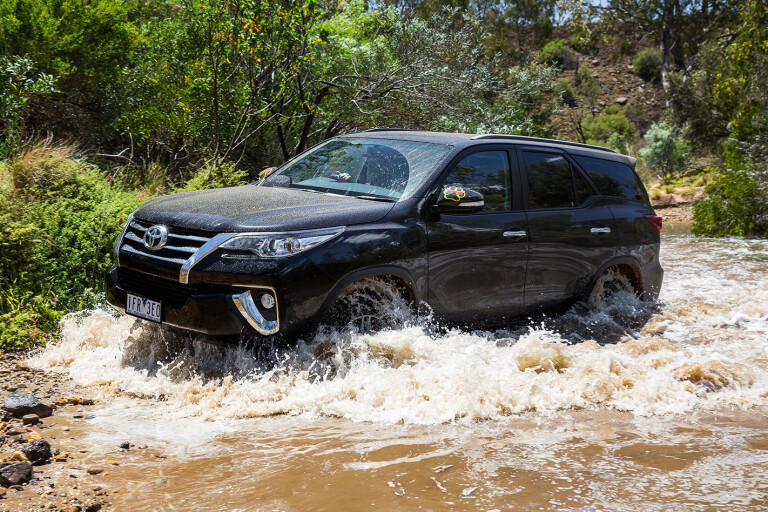
The Fortuner is another new nameplate for Australia and, like the Everest, it’s one that has been used overseas for previous generations of the vehicle.
While the Fortuner is new to Australia, it could have easily been called the 4Runner, as it carries on the tradition of that vehicle as a wagon version of the popular Hilux ute. Sound familiar?
With the eighth-generation Hilux also fresh off the boat, Toyota has re-introduced the wagon variant and given it the name used in Asian countries, whereas the US still uses the legendary 4Runner moniker. In line with the latest Hilux, the Fortuner gets the new 2.8-litre four-cylinder 1GD diesel engine with a six-speed auto, or a manual transmission, and part-time 4x4 with a two-speed transfer case.
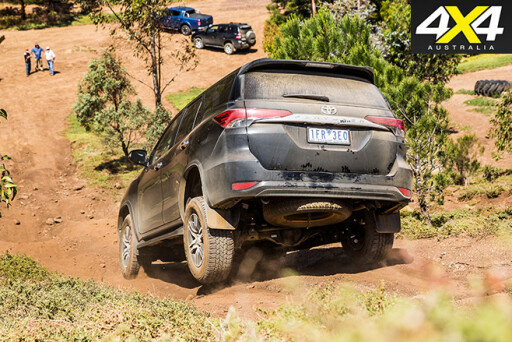 The Fortuner has a 335mm-shorter wheelbase than the Hilux ute, while multi-links with coil springs at the rear replace the utes leaves, and disc brakes are used in lieu of drums down back.
The Fortuner has a 335mm-shorter wheelbase than the Hilux ute, while multi-links with coil springs at the rear replace the utes leaves, and disc brakes are used in lieu of drums down back.
Toyota has given its wagon bespoke front sheet metal, so the Fortuner isn’t instantly recognisable as a Hilux derivative. Inside, there’s a different dash treatment to provide a more upmarket feel than that of the workhorse. It has succeeded here, as the cabin has a quality feel and look about it, especially if the brown seat trim colour grows on you.
There are more soft-touch points around the cabin than in the Hilux (and other wagons in the segment) to give a premium feel, even in the mid-spec GXL variant we had at 4X4OTY.
TOURING
Toyota has delivered a sweet suspension tune on the Fortuner, giving it a relaxed and comfortable ride over broken back-country and gravel roads.
 The engine has adequate power, but it’s no missile and you find it lacking when you want to overtake from around 80-90km/h – the go pedal doesn’t seem to want to go down far enough.
The engine has adequate power, but it’s no missile and you find it lacking when you want to overtake from around 80-90km/h – the go pedal doesn’t seem to want to go down far enough.
The Fortuner is geared very tall for fuel economy, and out on the open highway the engine ticks over at around 1300rpm. As a result, the six-speed auto willingly shifts back a cog at the mere hint of an incline, and that makes it feel busy at times as it hunts for a ratio and converter lock-up. It’s also annoying on arterial roads when it drops to top gear/locked converter at 80km/h and the engine thrums and drones at such low revs.
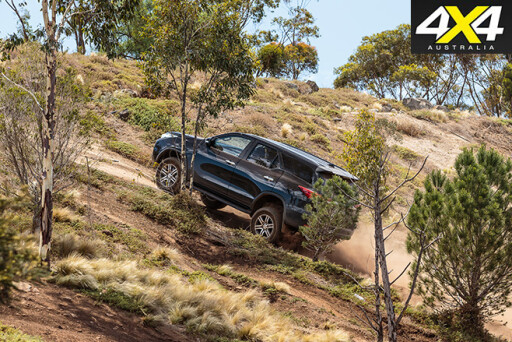 On test, the Fortuner sipped 11.8L/100km (on the back of an 8.6L/100km official rating). It has an 80-litre fuel tank, so it offers a good highway touring range.
On test, the Fortuner sipped 11.8L/100km (on the back of an 8.6L/100km official rating). It has an 80-litre fuel tank, so it offers a good highway touring range.
TRAIL DRIVING
With just a part-time 4x4 system to work with, you need the centre diff locked any time you are in four-wheel drive, which can be annoying when you have tight manoeuvring, multi-point turns or varying sealed/unsealed roads to contend with. The electronic traction control does an excellent job of keeping drive to the wheels with grip, regardless of the surface or incline.
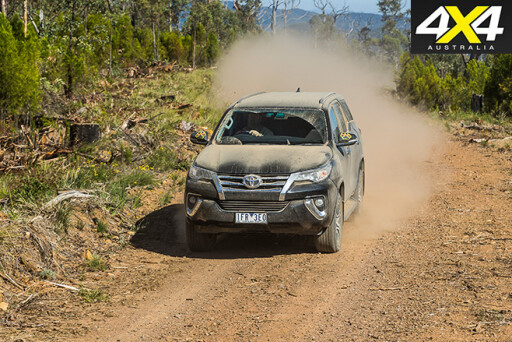 Low-speed punch from the engine is always on tap; the auto is quick to shift back to control-descent speeds even when you leave it in drive or use the paddle shifters; visibility over the bonnet is good; and all-in-all the Fortuner’s extremely capable on the tracks.
Low-speed punch from the engine is always on tap; the auto is quick to shift back to control-descent speeds even when you leave it in drive or use the paddle shifters; visibility over the bonnet is good; and all-in-all the Fortuner’s extremely capable on the tracks.
SET-PIECE HILL CLIMB
The way we tackle our rutted climb is to use every piece of tractive weaponry a car has on offer. We then run each car up the same straight line through the deepest parts of the ruts. The idea is that if you employ all the kit available, you’re giving the vehicle the best chance of making the climb. For the Fortuner, and most of the cars on this test, that meant using low range with the rear diff lock (RDL) engaged.
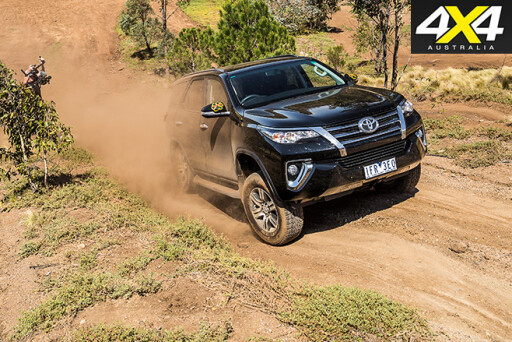 To our surprise, the Fortuner struggled with its RDL engaged – the rear wheels spun excessively, slewing the car off track and kicking up a dust storm. It made it up, but only when driven off the hard line.
To our surprise, the Fortuner struggled with its RDL engaged – the rear wheels spun excessively, slewing the car off track and kicking up a dust storm. It made it up, but only when driven off the hard line.
We then disengaged the RDL and, lo and behold, the electronic traction control made the climb look easy. The Fortuner got to the top with no wheel spin, no fuss and no sweat.
In the name of durability, Toyota has designed the car to disable ETC when the RDL is engaged, but it’s done such a top job calibrating the ETC that we were left wondering if there’s a use for a diff lock at all.
CABIN, EQUIPMENT AND ACCOMMODATION
The Fortuner cabin has a premium look and feel about it. That said, a few of our testers found that the driver’s seat was too small in the squab; we were surprised there was no climate control air-con and no sat-nav in GXL trim; and everyone hated the omission of the volume dial for the audio system, as the buttons on the tablet-style unit are fiddly and slow to use.
 The third-row seats fold up to the sides of the cargo area and infringe on space when not in use. The seats are okay for kids but not as comfortable as those in the Everest, and the small rear windows restrict the vision of anyone sitting back there. The absence of any tie-down points in the cargo area is also a huge negative.
The third-row seats fold up to the sides of the cargo area and infringe on space when not in use. The seats are okay for kids but not as comfortable as those in the Everest, and the small rear windows restrict the vision of anyone sitting back there. The absence of any tie-down points in the cargo area is also a huge negative.
Power-wise, there is a 12-volt outlet and a USB outlet up front, a 220-volt outlet in the console and another 12-volt outlet in the back. Just be careful if you’re plugging your car fridge in the back, as there’s nothing to safely tie it down to.
PRACTICALITIES
265/65R17s, as fitted to the GXL, are one of the most common 4x4 tyres sizes, so there are plenty of options available just about anywhere. But your smile will fade if you want to go up a size, as the Fortuner and Hilux have very limited space in the wheel wells.
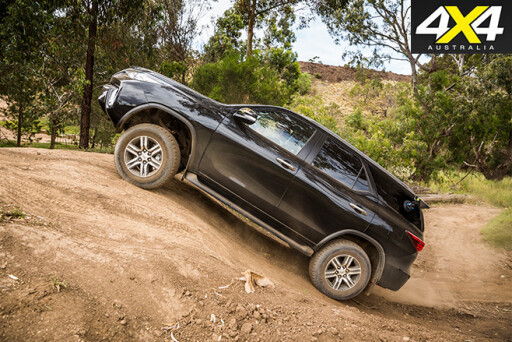 Even a 265/70 will scrub on vehicles with a legal suspension lift. Without extensive modifications, you can forget about big tyres on these new Toyotas.
Even a 265/70 will scrub on vehicles with a legal suspension lift. Without extensive modifications, you can forget about big tyres on these new Toyotas.
There’s space in the engine bay for a second battery and probably a third if you wanted one. The air cleaner is a good size and accessible without tools, and it sucks via the inner ’guard. Toyota offers a factory snorkel among a massive range of off-road accessories, and the clever aftermarket companies already have ranges of off-road gear available.
Heavy-duty protection plates under the Fortuner are a nice touch from Toyota, as are front and rear tow hooks.
SUMMARY
Roothy reckons: “The Fortuner is going to make someone somewhere very happy, but in this pack it’s lost by Prado’s perfection and Ford’s form. It’s a great vehicle, but I’m not sure why Toyota bothered.”
 That pretty much sums up what most of us thought: the Fortuner does what you expect of it but doesn’t shine in any particular area. It’s no Prado! Of more concern, though, was the lack of equipment and mediocre highway performance that let down an otherwise neat package.
That pretty much sums up what most of us thought: the Fortuner does what you expect of it but doesn’t shine in any particular area. It’s no Prado! Of more concern, though, was the lack of equipment and mediocre highway performance that let down an otherwise neat package.
SPECS
Engine: DOHC 16-valve 4-cyl turbodiesel
Capacity: 2.8-litre (2755cc)
Max power: 130kW @ 3400rpm
Max torque: (man) 420Nm @ 1400-2600rpm
Max torque: (auto) 450Nm @ 1600-2400rpm
Gearbox(s): 6-speed man/6-speed auto
4X4 System: part-time dual-range
Crawl Ratio: man/auto 44.0:1/36.1:1
Construction: separate chassis
Front suspension: independent/coil springs
Rear suspension: live axle/coil springs
Tyre size: (GX/GLX) 265/65R17 112S
Tyre size: (Crusade) 265/60 R18 110H
Kerb Mass: 2110-2135kg
GVM: 2750Kg
Payload: 615-640kg
Tow rating: man/auto 3000kg/2800kg
GCM: man/auto 5745kg/5545kg
Seating capacity: seven
Fuel tank capacity: 80 litres
Fuel use on test: 11.8L/100km
ADR fuel use auto: 8.6L/100km
Price: $54,990 (inc auto)
MORE 4X4 OF THE YEAR
 HOME: 4X4 OF THE YEAR 2016
HOME: 4X4 OF THE YEAR 2016
On the shortlist for 4X4OTY 2016 were the Hilux, Triton, Fortuner, Prado, Navara and Everest.
 THE FINALISTS
THE FINALISTS
The six best 4x4 vehicles of 2015 battling it out to be crowned 4x4 Of The Year 2016.
 THE RESULTS
THE RESULTS
Only one of the six best 4x4s from 2015 can be crowned 4x4 Of The Year 2016
 4X4 OF THE YEAR HOME
4X4 OF THE YEAR HOME
Finding Australia's Best 4x4s

COMMENTS